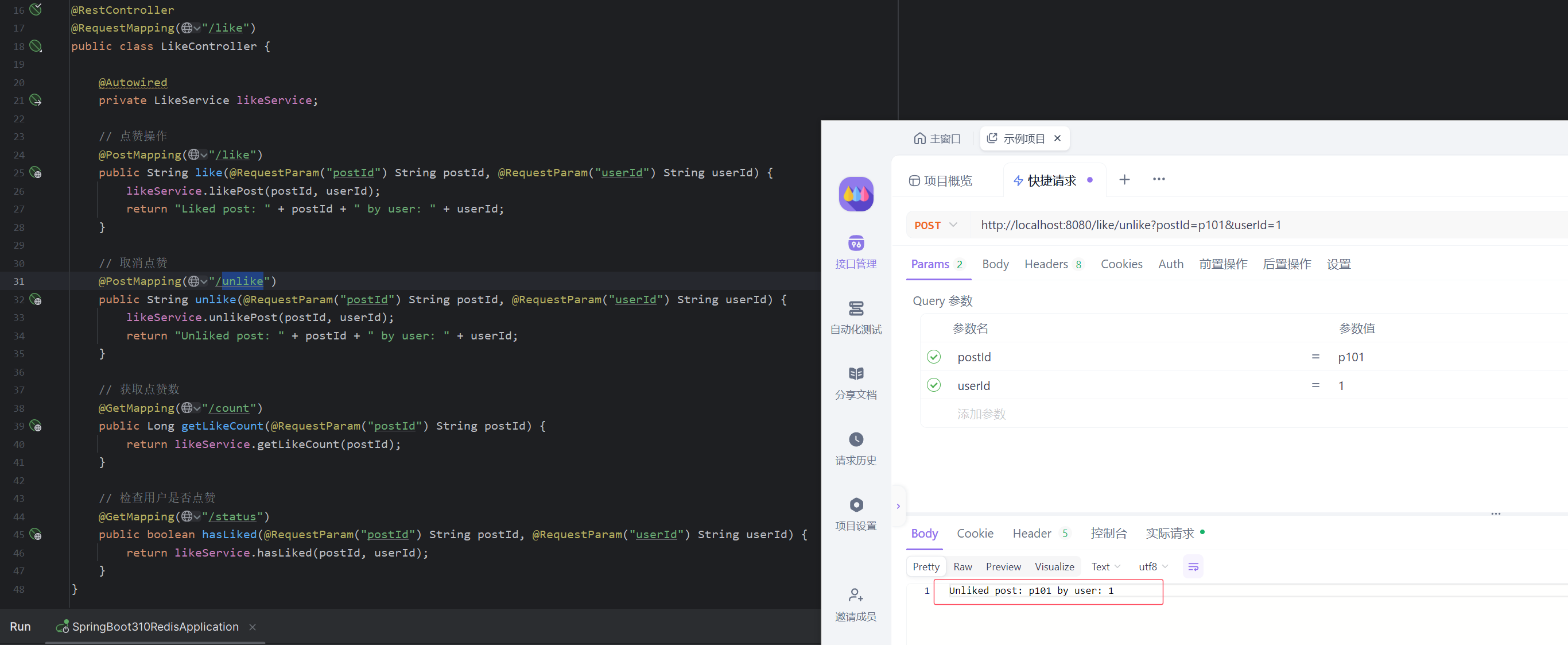在现代的应用中,点赞功能是一个非常常见的需求,尤其在社交媒体、博客等平台上。Redis 作为一个高性能的键值存储系统,由于其读写速度快、支持丰富的数据结构,因此非常适合用来实现实时的点赞功能。本文将介绍如何结合 Spring Boot 3 和 Redis 来实现一个高效的点赞功能。
1. 点赞功能的场景分析
点赞功能通常涉及以下场景:
- 用户点赞或取消点赞:某个用户对某篇文章或某条评论进行点赞或取消操作。
- 统计点赞数量:实时显示某个对象(如文章、视频、评论)的总点赞数。
- 用户点赞状态查询:判断某个用户是否对某个对象点赞过。
Redis 通过Set 数据结构可以很好地解决这些问题。Redis 的 Set 不允许重复元素,且支持快速添加、删除、判断成员是否存在等操作。

2. 项目环境配置
2.1. 依赖引入
首先,在 pom.xml 中引入 Spring Boot 3 和 Redis 的相关依赖,具体参考重学SpringBoot3-集成Redis(一)之基本使用:
<dependency>
<groupId>org.springframework.boot</groupId>
<artifactId>spring-boot-starter-data-redis</artifactId>
</dependency>
2.2. Redis 配置
在 application.yml 中配置 Redis 连接:
spring:
data:
redis:
host: localhost
port: 6379 # Redis 端口
password: redis123456 # 如果有密码可以在这里配置
lettuce:
pool:
max-active: 100 # 最大并发连接数
max-idle: 50 # 最大空闲连接数
min-idle: 10 # 最小空闲连接数
3. 点赞功能的实现
在实现点赞功能时,通常会用 Redis 的 Set 数据结构来存储每个对象(如文章、视频)的点赞用户列表。每次点赞操作就是往这个 Set 中添加用户 ID,取消点赞则是从 Set 中移除用户 ID。
3.1. 点赞服务层
package com.coderjia.boot310redis.service;
import org.springframework.beans.factory.annotation.Autowired;
import org.springframework.data.redis.core.StringRedisTemplate;
import org.springframework.stereotype.Service;
/**
* @author CoderJia
* @create 2024/10/10 下午 09:45
* @Description
**/
@Service
public class LikeService {
@Autowired
private StringRedisTemplate redisTemplate;
// Redis Key 前缀
private static final String LIKE_KEY_PREFIX = "like:";
// 用户点赞
public void likePost(String postId, String userId) {
String redisKey = LIKE_KEY_PREFIX + postId;
redisTemplate.opsForSet().add(redisKey, userId);
}
// 用户取消点赞
public void unlikePost(String postId, String userId) {
String redisKey = LIKE_KEY_PREFIX + postId;
redisTemplate.opsForSet().remove(redisKey, userId);
}
// 查询某个帖子点赞数
public Long getLikeCount(String postId) {
String redisKey = LIKE_KEY_PREFIX + postId;
return redisTemplate.opsForSet().size(redisKey);
}
// 判断用户是否点赞
public boolean hasLiked(String postId, String userId) {
String redisKey = LIKE_KEY_PREFIX + postId;
return Boolean.TRUE.equals(redisTemplate.opsForSet().isMember(redisKey, userId));
}
}
3.2. 点赞控制器
package com.coderjia.boot310redis.demos.web;
import com.coderjia.boot310redis.service.LikeService;
import org.springframework.beans.factory.annotation.Autowired;
import org.springframework.web.bind.annotation.GetMapping;
import org.springframework.web.bind.annotation.PostMapping;
import org.springframework.web.bind.annotation.RequestMapping;
import org.springframework.web.bind.annotation.RequestParam;
import org.springframework.web.bind.annotation.RestController;
/**
* @author CoderJia
* @create 2024/10/10 下午 09:46
* @Description
**/
@RestController
@RequestMapping("/like")
public class LikeController {
@Autowired
private LikeService likeService;
// 点赞操作
@PostMapping("/like")
public String like(@RequestParam String postId, @RequestParam String userId) {
likeService.likePost(postId, userId);
return "Liked post: " + postId + " by user: " + userId;
}
// 取消点赞
@PostMapping("/unlike")
public String unlike(@RequestParam String postId, @RequestParam String userId) {
likeService.unlikePost(postId, userId);
return "Unliked post: " + postId + " by user: " + userId;
}
// 获取点赞数
@GetMapping("/count")
public Long getLikeCount(@RequestParam String postId) {
return likeService.getLikeCount(postId);
}
// 检查用户是否点赞
@GetMapping("/status")
public boolean hasLiked(@RequestParam String postId, @RequestParam String userId) {
return likeService.hasLiked(postId, userId);
}
}
3.3. 演示
点赞操作
post http://localhost:8080/like/like?postId=p101&userId=1

获取点赞数
GET http://localhost:8080/like/count?postId=p101

检查用户是否点赞
GET http://localhost:8080/like/status?postId=p101&userId=1

取消点赞
POST http://localhost:8080/like/unlike?postId=p101&userId=1

4. 点赞功能的详细解释
4.1. 用户点赞和取消点赞
每当用户点赞时,我们将用户 ID 存入 Redis 的 Set 中。由于 Redis 的 Set 不允许重复元素,用户多次点赞同一篇文章也只会被记录一次。
redisTemplate.opsForSet().add(redisKey, userId);
取消点赞则是将用户 ID 从 Set 中移除:
redisTemplate.opsForSet().remove(redisKey, userId);
4.2. 统计点赞数
统计点赞数非常简单,直接调用 Redis 的 size() 方法即可:
redisTemplate.opsForSet().size(redisKey);
这比使用传统数据库查询要快得多,尤其在大量用户点赞的情况下,Redis 能保持高性能。
4.3. 判断用户是否点赞
可以通过 Redis 的 isMember() 方法来判断某个用户是否已经对某篇文章点赞:
redisTemplate.opsForSet().isMember(redisKey, userId);
这一点对前端显示用户是否已点赞的状态非常重要,用户体验更好。
5. Redis Set 数据结构的优势
Redis 的 Set 数据结构非常适合用来存储点赞功能的用户列表,原因有以下几点:
- 唯一性:Redis Set 不允许重复元素,确保用户对同一篇文章只能点赞一次。
- 高性能:Redis 是内存级存储,读写速度极快,适合大规模的点赞操作。
- 丰富的操作:Set 提供了丰富的操作,如添加成员、删除成员、计算数量、检查成员是否存在等,这些操作都是 O(1) 复杂度,性能非常高。
6. 总结
通过结合 Spring Boot 3 与 Redis,我们可以轻松实现高效的点赞功能,并利用 Redis 的 Set 数据结构实现去重、快速统计等操作。相比于传统的数据库操作,使用 Redis 实现的点赞功能性能更高、扩展性更好,尤其适合用户量大、点赞操作频繁的应用场景。
持久化到数据库
仅使用 Redis:适用于对数据一致性要求不高的场景,比如短期有效的点赞数据,或者系统对少量点赞数据丢失不敏感。
Redis + MySQL方案:适用于对数据一致性要求高的场景,比如电商、社交平台中,点赞数据不能丢失,且需要长期保存。通常采用异步持久化,具体流程可以是:
- 用户点赞时,首先将数据写入 Redis。
- 通过定时任务(如每隔几分钟)或消息队列,将 Redis 中的点赞数据同步到数据库。
- 在定时任务或队列消费过程中,可以批量将点赞数据写入数据库,降低数据库的写入压力。
除了点赞功能,Redis 还可以应用于排行榜、实时统计等功能,帮助提升系统的性能和用户体验。在未来的开发中,我们可以探索更多 Redis 的使用场景,充分发挥其优势。
